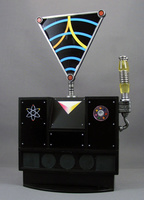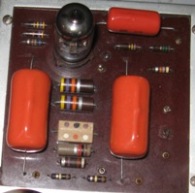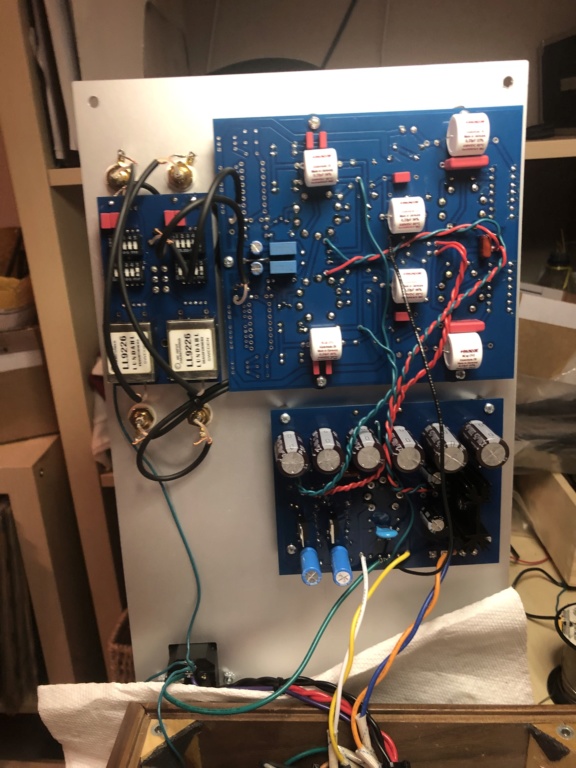5 posters
How to verify the input load impedance on a phono pre

Skydogcable- Posts : 28
Join date : 2018-12-04
I have a ph16 with step up transformers installed for a MC cartridge. Being the obsessive weirdo that I am, I want to measure the load on that input. Is there a quick way to measure the impedance through the SUT to ensure a proper cart load or should I just trust that it’s all good and move on?

Peter W.- Posts : 1351
Join date : 2016-08-07
Location : Melrose Park, PA
Skydogcable wrote:I have a ph16 with step up transformers installed for a MC cartridge. Being the obsessive weirdo that I am, I want to measure the load on that input. Is there a quick way to measure the impedance through the SUT to ensure a proper cart load or should I just trust that it’s all good and move on?
The SUT eliminates any issues with the cartridge impedance. Transformers have that virtue, and given that these are also designed for the purpose, you need not even worry about the impedance between the SUT and the actual active phono section.

Skydogcable- Posts : 28
Join date : 2018-12-04
Loading still matters. It’s just affect by a 100:1 ratio. I just like to verify stuff with measurements when possible.

Skydogcable- Posts : 28
Join date : 2018-12-04
From Roy
Moving Coil Cartridge Step-up Transformers
It is difficult to amplify the microvolt level signals present at the output of most moving coil phono cartridges without adding audible noise. With transistor-based preamplifiers it is possible to do so using special techniques; it is even more difficult to do with tubes. However, a step-up transformer can be used to increase, or in transformer lingo, "step up", the cartridge voltage admirably without adding any perceivable noise.
The moving coil cartridge is a truly low impedance voltage generator. Because of this it is possible to use a transformer to step up the voltage by factors of 10 or more times without causing any impedance interface problems with conventional phono preamplifiers. When a transformer is used to step up a voltage, the characteristic cartridge impedance (AC resistance) is also increased. The mathematical relationship is such that a 10-fold increase in voltage results in a 100-fold increase in impedance.
In general, the impedance transformation through a transformer is equal to the square of the voltage transformation. It is important to take both of these parameters into account when deciding what sort of an MC step-up transformer is required to make a given cartridge work well with the phono preamp you have.
To make the theory real, let’s set up a hypothetical example. Imagine an MC cartridge that has a nominal 0.5 mV output and a phono preamplifier that has a 47K input impedance. If we desire to increase the output voltage of the MC cartridge to the “normal” 5 mV level associated with most MM phono cartridges where the phono preamp gives acceptable noise performance, then we would require a 10-fold increase in signal level. To do this, we connect the primary coils on the Lundahl LL9226 in the configuration that results in a gain of 10, or expressed in dB, 20dB, and then wire it up to our preamp and enjoy some tunes. (See the diagram below for an illustration of the hypothetical connection described here) But before we drop the stylus onto the record, we need to also consider the impedance implications of our gain decision. Because the gain we chose was 10, we have an impedance transformation of 10 squared, or 100. So, the cartridge “sees” the 47K load resistor at the input to the preamp through the transformer as being 470 ohms, which is arrived at by dividing the resistor value, 47K, by 100, the impedance ratio. Most MC cartridge manufacturers provide a recommended range for load impedance (or resistance). Because this value is usually substantially lower than 47K, the transformer is performing a valuable service on the impedance front, as well. A typical MC cartridge will sound somewhat “lightweight” when it is loaded too lightly (load impedance is too high) and will sound somewhat dull when the load impedance is too low. So, it’s important to get both of these parameters, the step-up gain and the reflected load impedance, correct to get the best sound. The gain you choose generally has less effect on the sound quality than does the cartridge loading. So it’s important to get the gain in the “ballpark”, but then turn serious attention to adjusting the cartridge loading to get good frequency balance as described above. The discussion below will guide your efforts in this direction.
One feature of the diagram below deserves additional comment. The grounding arrangement around the transformer is appropriate for the vast majority of installations where the phono preamp has unbalanced inputs and the cabling from the turntable to the MC step-up transformer is two conductor wire terminated with an RCA plug.
You might now ask if when you need a gain of 10, are you then “stuck” with a reflected 470ohm load for your cartridge, even if that’s not optimum? To increase the load impedance above 470 ohms, you either have to remove the 47K resistor and replace it with a higher value resistor or you have to settle for a lower step-up gain. Fortunately, it’s most often true that the MC cartridges that have the lowest output levels also require relatively low values of load impedance, so this is not usually a problem.
(with the PH16 input load switching, you can select 68K, 47K, or 33K)
For those of you who want to experiment with and optimize your cartridge loading (recommended!), we have provided tables of parallel resistance values that will help you achieve the best sound. As a starting point, I usually chose a load impedance value of 10 times the cartridge impedance (sometimes referred to as resistance in cartridge data sheets). The values given in the tables are referenced to the step-up gains produced by the LL9206 and the LL1678. Note that these values don’t scale precisely with the square of the step-up gain. The primary and secondary resistances of the transformer also figure into the calculation.
LL9226
Desired Load Impedance (ohms)
Step-Up Gain
Phono Preamp Input Impedance
Parallel Resistor Required (ohms)
1600
5
47K
307000
800
5
47K
37200
400
5
47K
14000
200
5
47K
6570
100
5
47K
3500
50
5
47K
2100
Desired Load Impedance (ohms)
Step-Up Gain
Phono Preamp Input Impedance
Parallel Resistor Required (ohms)
400
10
47K
307000
300
10
47K
89000
200
10
47K
37200
100
10
47K
14000
60
10
47K
7900
40
10
47K
5300
Desired Load Impedance (ohms)
Step-Up Gain
Phono Preamp Input Impedance
Parallel Resistor Required (ohms)
100
20
47K
307000
80
20
47K
108000
60
20
47K
52300
40
20
47K
26000
20
20
47K
10800
Moving Coil Cartridge Step-up Transformers
It is difficult to amplify the microvolt level signals present at the output of most moving coil phono cartridges without adding audible noise. With transistor-based preamplifiers it is possible to do so using special techniques; it is even more difficult to do with tubes. However, a step-up transformer can be used to increase, or in transformer lingo, "step up", the cartridge voltage admirably without adding any perceivable noise.
The moving coil cartridge is a truly low impedance voltage generator. Because of this it is possible to use a transformer to step up the voltage by factors of 10 or more times without causing any impedance interface problems with conventional phono preamplifiers. When a transformer is used to step up a voltage, the characteristic cartridge impedance (AC resistance) is also increased. The mathematical relationship is such that a 10-fold increase in voltage results in a 100-fold increase in impedance.
In general, the impedance transformation through a transformer is equal to the square of the voltage transformation. It is important to take both of these parameters into account when deciding what sort of an MC step-up transformer is required to make a given cartridge work well with the phono preamp you have.
To make the theory real, let’s set up a hypothetical example. Imagine an MC cartridge that has a nominal 0.5 mV output and a phono preamplifier that has a 47K input impedance. If we desire to increase the output voltage of the MC cartridge to the “normal” 5 mV level associated with most MM phono cartridges where the phono preamp gives acceptable noise performance, then we would require a 10-fold increase in signal level. To do this, we connect the primary coils on the Lundahl LL9226 in the configuration that results in a gain of 10, or expressed in dB, 20dB, and then wire it up to our preamp and enjoy some tunes. (See the diagram below for an illustration of the hypothetical connection described here) But before we drop the stylus onto the record, we need to also consider the impedance implications of our gain decision. Because the gain we chose was 10, we have an impedance transformation of 10 squared, or 100. So, the cartridge “sees” the 47K load resistor at the input to the preamp through the transformer as being 470 ohms, which is arrived at by dividing the resistor value, 47K, by 100, the impedance ratio. Most MC cartridge manufacturers provide a recommended range for load impedance (or resistance). Because this value is usually substantially lower than 47K, the transformer is performing a valuable service on the impedance front, as well. A typical MC cartridge will sound somewhat “lightweight” when it is loaded too lightly (load impedance is too high) and will sound somewhat dull when the load impedance is too low. So, it’s important to get both of these parameters, the step-up gain and the reflected load impedance, correct to get the best sound. The gain you choose generally has less effect on the sound quality than does the cartridge loading. So it’s important to get the gain in the “ballpark”, but then turn serious attention to adjusting the cartridge loading to get good frequency balance as described above. The discussion below will guide your efforts in this direction.
One feature of the diagram below deserves additional comment. The grounding arrangement around the transformer is appropriate for the vast majority of installations where the phono preamp has unbalanced inputs and the cabling from the turntable to the MC step-up transformer is two conductor wire terminated with an RCA plug.
You might now ask if when you need a gain of 10, are you then “stuck” with a reflected 470ohm load for your cartridge, even if that’s not optimum? To increase the load impedance above 470 ohms, you either have to remove the 47K resistor and replace it with a higher value resistor or you have to settle for a lower step-up gain. Fortunately, it’s most often true that the MC cartridges that have the lowest output levels also require relatively low values of load impedance, so this is not usually a problem.
(with the PH16 input load switching, you can select 68K, 47K, or 33K)
For those of you who want to experiment with and optimize your cartridge loading (recommended!), we have provided tables of parallel resistance values that will help you achieve the best sound. As a starting point, I usually chose a load impedance value of 10 times the cartridge impedance (sometimes referred to as resistance in cartridge data sheets). The values given in the tables are referenced to the step-up gains produced by the LL9206 and the LL1678. Note that these values don’t scale precisely with the square of the step-up gain. The primary and secondary resistances of the transformer also figure into the calculation.
LL9226
Desired Load Impedance (ohms)
Step-Up Gain
Phono Preamp Input Impedance
Parallel Resistor Required (ohms)
1600
5
47K
307000
800
5
47K
37200
400
5
47K
14000
200
5
47K
6570
100
5
47K
3500
50
5
47K
2100
Desired Load Impedance (ohms)
Step-Up Gain
Phono Preamp Input Impedance
Parallel Resistor Required (ohms)
400
10
47K
307000
300
10
47K
89000
200
10
47K
37200
100
10
47K
14000
60
10
47K
7900
40
10
47K
5300
Desired Load Impedance (ohms)
Step-Up Gain
Phono Preamp Input Impedance
Parallel Resistor Required (ohms)
100
20
47K
307000
80
20
47K
108000
60
20
47K
52300
40
20
47K
26000
20
20
47K
10800

Dave_in_Va- Posts : 446
Join date : 2013-04-02
Location : Mid. VA
Whew...I'm glad I stuck with a moving magnet cartridge!

WLT- Posts : 189
Join date : 2013-07-13
Location : Rochester NY
Great write up from Roy.
The bottom line is the SUT will have a specific gain (in his write up it is 10) and the PH 16 preamp has a specific input resistance (most preamps are 47k ohms but check yours). That will allow you to calculate the input impedance as 470 ohms for a MM cartridge.
The request for measurement you ask for is then a request to measure the output impedance of the MM cartridge at all audio frequencies. Not a measurement of the preamp or SUT. My guess is that only the large cartridge manufacturers would have the test equipment and procedures to perform this work. It may be worthwhile for you to contact your cartridge manufacturer and ask about any test results they would feel comfortable publishing. They would not get many requests for such data.
An analogy would be a speaker’s impedance given that you have an 8 ohm tap set on you amp. The nominal 8 ohm speaker impedance varies quite a bit thru the audio spectrum based on resonant frequency, driver inductance etc. Your cartridge also has its output vary thru frequency due to many factors as well.
The parallel resistance values that Roy alludes to are some things to try to see if you like the sound better one way or the other. In a moving magnet preamp I built I have a switch that allows me to insert up to 5 different value input resistors so I can experiment. Similar thought process but I do not have any MC cartridges.
The bottom line is the SUT will have a specific gain (in his write up it is 10) and the PH 16 preamp has a specific input resistance (most preamps are 47k ohms but check yours). That will allow you to calculate the input impedance as 470 ohms for a MM cartridge.
The request for measurement you ask for is then a request to measure the output impedance of the MM cartridge at all audio frequencies. Not a measurement of the preamp or SUT. My guess is that only the large cartridge manufacturers would have the test equipment and procedures to perform this work. It may be worthwhile for you to contact your cartridge manufacturer and ask about any test results they would feel comfortable publishing. They would not get many requests for such data.
An analogy would be a speaker’s impedance given that you have an 8 ohm tap set on you amp. The nominal 8 ohm speaker impedance varies quite a bit thru the audio spectrum based on resonant frequency, driver inductance etc. Your cartridge also has its output vary thru frequency due to many factors as well.
The parallel resistance values that Roy alludes to are some things to try to see if you like the sound better one way or the other. In a moving magnet preamp I built I have a switch that allows me to insert up to 5 different value input resistors so I can experiment. Similar thought process but I do not have any MC cartridges.

Skydogcable- Posts : 28
Join date : 2018-12-04
I’m not trying to measure my cartridge. I’m trying to measure the actual impedance that the preamp is showing the cartridge. This is an old write up. The new versions of the ph16 have selectable loads via dip switches. In order for the cartridge to see a 100ohm load through the SUT a 10k resistor is engaged. The 100:1 ratio brings that down to 100ohm. I’m trying to figure out if that is an exact 100:1 ratio through measurement. If it’s not exact then that would affect the sound. There’s and audible difference from 50-150ohms and it would not take much of a skew to have that much of a delta. Of course I could just play with the settings and use my ear but the dip switches are hidden in the case. I know this cartridge well and it sounds best as close to 100ohms as possible. I’m hearing a little peaking In The last octave which makes me think the load may be a little high. I would like to verify what it actually is if that is even possible with a standard meter.

Peter W.- Posts : 1351
Join date : 2016-08-07
Location : Melrose Park, PA
The preamp is "seeing" the secondary of the SUT. Not the cartridge itself. As with all such things, that will be frequency dependent. And, as it happens, independent of what the Primary is seeing.

Skydogcable- Posts : 28
Join date : 2018-12-04
Im not worried about the preamp side. My concern is with the load that the cartridge sees.
From Roy’s write up:
Note that these values don’t scale precisely with the square of the step-up gain. The primary and secondary resistances of the transformer also figure into the calculation.
That tells me that engadging the 10k resistor does not give me an exact 100ohm load. I’m trying to verify through measurement what that load actually is.


From Roy’s write up:
Note that these values don’t scale precisely with the square of the step-up gain. The primary and secondary resistances of the transformer also figure into the calculation.
That tells me that engadging the 10k resistor does not give me an exact 100ohm load. I’m trying to verify through measurement what that load actually is.



Peter W.- Posts : 1351
Join date : 2016-08-07
Location : Melrose Park, PA
You miss the point. Not hard given the situation, so that is not snarky comment. A transformer may be seen as the universal equalizer. Measure the *Resistance* of the primary side.
https://www.electronics-tutorials.ws/accircuits/ac-resistance.html will allow you to calculate impedance across whatever frequency range you wish - as if the primary were a purely resistive load.
Your SUT will be running at a very small percentage of its absolute load, which allows for the large increase. But, again, the cartridge sees, effectively, a constant load. You are not trying to run a motor on the secondary side - the motor (transducer) is on the primary side.
https://www.electronics-tutorials.ws/accircuits/ac-resistance.html will allow you to calculate impedance across whatever frequency range you wish - as if the primary were a purely resistive load.
Your SUT will be running at a very small percentage of its absolute load, which allows for the large increase. But, again, the cartridge sees, effectively, a constant load. You are not trying to run a motor on the secondary side - the motor (transducer) is on the primary side.

Skydogcable- Posts : 28
Join date : 2018-12-04
Why would Roy design a circuit with selectable loads and put together this document if the SUT trumped everything? What you’re saying makes sense but sort of contradicts what Roy says about cartridge loading with this preamp. I get 250ohm no matter where I measure which jives with what your saying and I’m hearing. However if that is the case then this is a flawed design. The proper loading of a cartridge is important. Being stuck with a 250 ohm load is unacceptable when 90% of all MC cartridges need a 100ohm load. I have a feeling that we are both missing part of the picture. Using a step up transformer is pretty common in the MC world. I’m going to find a google rabbit hole to go down. Maybe the full answer is there.

Peter W.- Posts : 1351
Join date : 2016-08-07
Location : Melrose Park, PA
Pretty much because SUTs & Head-amps vary. Writing for myself, I find that SUTs are quite lossy, so I keep a head amp for the purpose, a different set of compromises.

Skydogcable- Posts : 28
Join date : 2018-12-04
Looks like Roy borrowed the write up. I think these are the guys that provide the out board SUT’s that Roy sells. I may have to just trust that it’s doung what it should.
http://www.kandkaudio.com/applications-guide/
http://www.kandkaudio.com/applications-guide/

Skydogcable- Posts : 28
Join date : 2018-12-04
So back to the load question. Is there a way to measure the reflected load to the cartridge when a SUT is part of the circuit?

Guest- Guest
Skydogcable wrote:So back to the load question. Is there a way to measure the reflected load to the cartridge when a SUT is part of the circuit?
don't know, I have never bothered to look into that......
Perhaps contact Kevin Carter at K&K Audio directly.

Skydogcable- Posts : 28
Join date : 2018-12-04
I was thinking the same thing. You are always super helpful at helping me see the Forrest for the trees.

Peter W.- Posts : 1351
Join date : 2016-08-07
Location : Melrose Park, PA
http://www.rothwellaudioproducts.co.uk/html/mc_step-up_transformers_explai.html
http://www.kandkaudio.com/applications-guide/
And Remember~!~ ladies and gentlemen, and children of all ages: Transformers transform VOLTAGE. The current remains the same, ignoring transformer losses.
http://www.kandkaudio.com/applications-guide/
And Remember~!~ ladies and gentlemen, and children of all ages: Transformers transform VOLTAGE. The current remains the same, ignoring transformer losses.

kaner- Posts : 93
Join date : 2011-09-20
Dave_in_Va wrote:Whew...I'm glad I stuck with a moving magnet cartridge!
My cartridge is moving iron? B&O MMC20E. I give up! Sounds great though...

